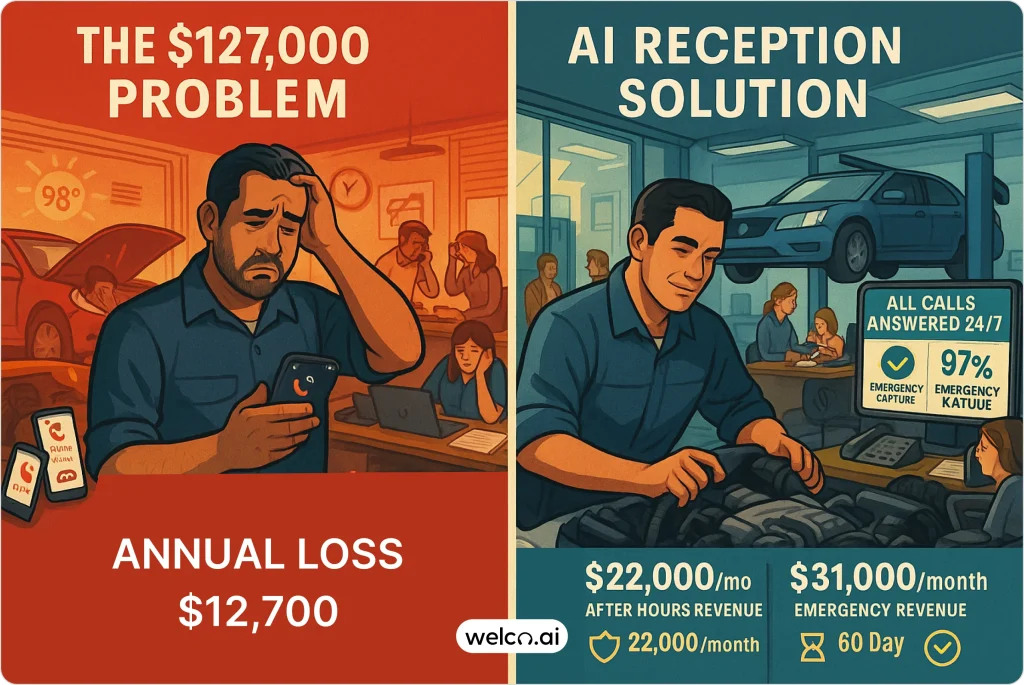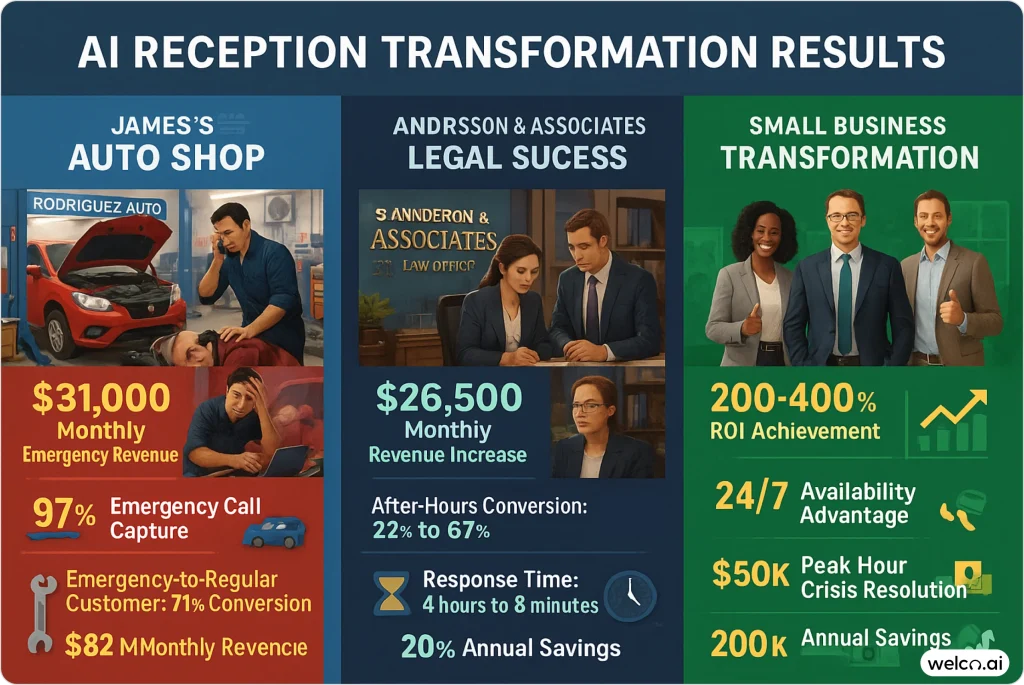James Rodriguez was about to discover the $127,000 mistake that was slowly killing his auto repair business.
His shop seemed fine on the surface. Revenue was steady, customers seemed happy, staff was competent.
But when he finally tracked his numbers, the truth was devastating: he was losing $127,000 annually from missed business calls.
Not from poor service or expensive parts. From an outdated approach to handling customer calls.
James’s story isn’t unique. Small businesses across every industry are hemorrhaging money through traditional phone systems while their competitors capture every opportunity with AI phone answering technology.
Whether you’re managing retail customer support or running professional services client intake, the challenge remains the same.

The Hidden Revenue Killer
Here’s what James found when he finally tracked his numbers:
- 40% of service calls happened after hours (all went to voicemail)
- $210 lost revenue per missed emergency repair
- 25% no-show rate due to poor appointment confirmation
- 3.5 hours daily staff time wasted on phone tag
The math was brutal: $127,000 in lost revenue that could have been captured with proper phone coverage.
Pro Tip: Most small business owners never calculate their missed-call revenue loss. The number is usually shocking.
When Peak Hours Become Breaking Points
James’s discovery led him to uncover an even bigger problem.
His service advisor, Maria, was overwhelmed during peak hours. She often put callers on hold for 4-6 minutes. During summer AC season, the phone rang constantly, and Maria couldn’t handle the volume.
Potential customers hung up and called competitors who answered immediately.
The breaking point came during a particularly busy Monday. Four emergency breakdowns called within an hour, but Maria was handling a complex warranty claim.
Three of those emergency calls went to competitors, representing $630 in immediate lost revenue.
That single morning cost James more than two months of AI virtual receptionist service.
Cost Comparison Reality Check
| Traditional Receptionist | AI Virtual Receptionist |
| $57,000-$64,000 annually | $300-$6,828 annually |
| 40 hours/week coverage | 168 hours/week coverage |
| Sick days, vacation time | Never takes a break |
| Training and turnover costs | One-time setup |

Following James’s Complete Journey
Six months after discovering his revenue loss, James implemented an automated phone answering system specifically designed for automotive service centers.
This AI phone agent transformation was immediate and measurable.
James’s Implementation Results (First Month):
- Emergency call capture increased from 60% to 97%
- After-hours service appointments went from zero to $22,000 monthly revenue
- No-show rates dropped from 25% to 12%
- Maria’s stress levels decreased dramatically as she focused on in-person customers
How James’s Smart Call System Works
When Tom’s car overheated on Interstate 95 during a 98°F Saturday afternoon, he called Rodriguez Auto expecting voicemail.
The AI virtual assistant immediately assessed the situation:
- Overheating emergency
- Highway location
- Extreme heat conditions
Within minutes, the system:
- Dispatched their mobile diagnostic partner
- Scheduled a Monday morning appointment for cooling system repair
- Checked parts availability in real-time
- Provided Tom with an accurate repair estimate
- Sent care instructions to prevent further damage
That single call generated $850 in emergency service fees plus a $1,200 cooling system repair.
Warning: James’s Competitive Advantage
Within three months of James implementing his AI answering service, two competing auto shops in his area noticed significant drops in emergency calls.
They quickly implemented their own systems, but James had already established his shop as the “always available” repair center in the community.
James now reports:
“The AI phone system has become our shop’s secret weapon. Customers know they can reach us any time, day or night. We’ve become the shop that other mechanics’ customers call when their regular place doesn’t answer.”
Calculate What You’re Losing Right Now
Before you make any decisions, take 2 minutes to calculate your hidden revenue loss:
- Count your missed calls last week (check your phone logs)
- Multiply by your average service value
- Multiply by 52 weeks
- Add your reception staff costs
Example Calculation:
- 15 missed calls × $200 average × 52 weeks = $156,000 annually
- Plus: $60,000 reception salary = $216,000 total opportunity cost
Most business owners are shocked by this number.
James was losing even more because automotive emergencies command premium pricing and often lead to major repair jobs.
Beyond Automotive: Legal Firm Success Story
This revenue loss pattern isn’t unique to automotive. Legal firms face similar challenges with even higher stakes.
Anderson & Associates was thriving during business hours but hemorrhaging opportunities after 5 PM.
Legal emergencies don’t follow business hours:
- DUI arrests happen at 2 AM
- Family crises explode on weekends
- Business disputes emerge during holidays
The Problem
Analysis of local legal advertising revealed that 78% of after-hours legal inquiries were going to competitors with 24/7 live answering services.
However, those traditional services couldn’t:
- Conduct proper legal intake
- Assess case urgency
- Handle confidential information properly
Anderson & Associates was losing approximately $95,000 annually from after-hours inquiries alone.
The Solution
24/7 AI virtual receptionist system with:
- Conflict checking capabilities
- Case assessment protocols
- Immediate attorney notification for urgent matters
Just like AI receptionists for healthcare practices (HIPAA compliance) and legal firms and confidential call management, legal firms require secure, confidential call management systems.
The Results (Confirmed by Firm’s Bookkeeper):
- Monthly revenue increased by $26,500 (range: $18K-$34K based on case complexity)
- After-hours lead conversion improved from 22% to 67%
- Average response time decreased from 4 hours to 8 minutes
- Client satisfaction scores increased from 71% to 89%
Real Case Example
When Sarah Mitchell was arrested for DUI at 1:30 AM on a Saturday, she called Anderson & Associates from the police station.
The AI immediately:
- Conducted intake procedures
- Checked for conflicts of interest
- Assessed the urgency (first offense, professional license at risk)
- Connected her to the duty attorney within 6 minutes
The quick response allowed the attorney to advise Sarah before her formal interview, potentially saving her teaching license.
This case generated $8,500 in fees and led to three referrals from Sarah’s teaching colleagues.
Anderson explains:
“Our AI virtual assistant handles the initial screening that used to consume 30% of our paralegals’ time. Now our staff focuses on high-value case preparation while the system manages intake and scheduling. It’s like having a senior paralegal working 24/7 for a fraction of the cost.”
Before vs After: The Transformation
Before AI Virtual Receptionist:
- Missed calls: 25-40% during peak hours
- After-hours capture: 0%
- Response time: 30 seconds to 5 minutes
- Consistency: Varies based on mood, training, experience
- Availability: 40 hours/week maximum
After AI Phone Agent:
- Missed calls: Less than 2%
- After-hours capture: 100%
- Response time: Under 10 seconds consistently
- Consistency: Identical professional service every time
- Availability: 168 hours/week guaranteed
The Modern Business Reality
Traditional call answering approaches face challenges that simply didn’t exist five years ago:
Customer Expectations Have Changed
Research shows that 90% of customers now expect businesses to respond within 10 minutes during business hours.
This expectation shift has accelerated dramatically with cloud phone system adoption.
After-hours expectations have also shifted. Customers who call at 8 PM expect:
- Immediate answers, or
- Intelligent systems that capture their information for next-day follow-up
James discovered this when he surveyed customers who had switched to competitors. The primary reason wasn’t price or service quality—it was availability and response time.
Labor Market Challenges
The traditional receptionist position faces significant challenges:
- 40% annual turnover rate industry-wide
- $3,200 average training costs per new hire
- 6-8 weeks time to full productivity
- 30-40% additional costs for benefits, sick days, and vacation coverage
The After-Hours Opportunity
Business hours represent an artificial constraint in today’s always-connected economy.
Critical needs don’t respect 9-to-5 schedules:
- Automotive emergencies
- Legal crises
- Home service needs
- Medical situations
IndustriIndustries like hospitality industry reception solutions and real estate lead qualification and management have already discovered that after-hours availability directly impacts:
- Revenue generation
- Customer satisfaction
- Competitive advantage
Every hour your phone goes unanswered represents lost opportunities that competitors might capture.
Quick Win: Your Action Plan
Based on James’s experience, here’s what you can do this week:
Week 1 Action Items:
- Audit your missed calls – Check your phone system for last month’s data
- Calculate your loss – Use the formula above to quantify your opportunity cost
- Research your competition – Call your top 3 competitors after hours to see how they handle inquiries
- Identify your peak crisis times – When do your most valuable calls typically come in?
James’s advice:
“I wish I had calculated my losses years earlier. The numbers were staggering, but they motivated immediate action. Don’t wait until you’re losing six figures annually like I was.”

The Bottom Line
James’s auto shop now captures every emergency breakdown call, schedules service appointments around the clock, and provides better customer experience than ever before.
His virtual receptionist software paid for itself in the first month and continues generating additional revenue that wouldn’t exist otherwise.
Six-Month Results:
- James’s shop became the preferred emergency repair center in his area
- Two other automotive shops implemented AI systems, but James’s first-mover advantage established his reputation as the “always available” repair shop
- The three shops with AI now capture 85% of emergency calls in their area
- Traditional shops struggle with declining after-hours business
- James generates an additional $31,000 monthly in emergency revenue
Unexpected Benefit:
Satisfied emergency customers become regular customers. James’s emergency-to-regular-customer conversion rate is 71%, meaning that after-hours availability not only generates immediate revenue but builds long-term relationships.
The question isn’t whether AI virtual receptionist systems work—James’s $31K monthly increase proves they do.
The question is how quickly you can implement it before your competition does.
Small business growth through AI reception has become a competitive advantage across industries, from financial services compliance and security to local service providers.
Ready to Stop Losing Money to Missed Calls?
Choose Your Next Step:
- See Your Industry Demo – Watch AI handle real scenarios from your industry (5 minutes)
- Calculate Your ROI – Free tool shows exactly what missed calls cost you (2 minutes)
- Start Free Trial – Full 14-day trial, no credit card required (Setup in 24 hours)
Frequently Asked Questions
How does this work for my specific industry?
Each industry has unique requirements:
- Legal: Confidentiality and conflict checking
- Automotive: DMS integration and emergency dispatch
- Healthcare: HIPAA compliance protocols
- Financial Services: Security and regulatory compliance
The AI adapts with industry-specific conversation flows and compliance protocols.
What about compliance and regulations?
Built-in compliance includes:
- Legal: Attorney-client privilege protection
- Automotive: FTC Safeguards Rule compliance
- Healthcare: HIPAA requirements
- General: Industry-specific data protection requirements
All interactions are logged and auditable.
How quickly can I expect results?
Timeline for results:
3-6 months: Full integration and maximum benefits
Immediate: Cost savings from reduced staffing needs
Week 1: Emergency-based industries often recover costs
45-60 days: Most businesses see positive ROI
What happens to my current reception staff?
AI phone answering augments rather than replaces human staff:
Result: Improved job satisfaction and productivity
AI handles: Routine scheduling and basic inquiries
Humans focus on: High-value customer interactions
Can the AI handle complex customer situations?
Yes, with intelligent escalation protocols:
- AI handles: 80-90% of routine interactions
- Seamless transfer: Complex issues go to appropriate staff members
- Full context: Staff receives complete interaction history
No dropped calls: Smooth handoff process ensures customer satisfaction
